《生物化学》课程PPT教学课件(留学生)Chapter 22 Amino acids - metabolism of carbon skeletons
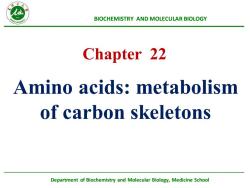
BIOCHEMISTRYANDMOLECULARBIOLOGY22ChapterAmino acids: metabolismof carbon skeletonsDepartmentof Biochemistry and Molecular Biology,MedicineSchool
Department of Biochemistry and Molecular Biology, Medicine School BIOCHEMISTRY AND MOLECULAR BIOLOGY Amino acids: metabolism of carbon skeletons Chapter 22
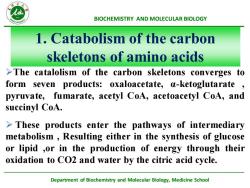
BIOCHEMISTRYANDMOLECULARBIOLOGYl. Catabolism of the carbonskeletonsofaminoacids>The catalolism of the carbon skeletons converges toform seven products: oxaloacetate, a-ketoglutarate pyruvate, fumarate, acetyl CoA, acetoacetyl CoA, andsuccinyl CoA.> These products enter the pathways of intermediarymetabolism , Resulting either in the synthesis of glucoseor lipid ,or in the production of energy through theiroxidation to CO2 and water by the citric acid cycle.Department of Biochemistry and Molecular Biology,Medicine School
Department of Biochemistry and Molecular Biology, Medicine School BIOCHEMISTRY AND MOLECULAR BIOLOGY 1. Catabolism of the carbon skeletons of amino acids ➢The catalolism of the carbon skeletons converges to form seven products: oxaloacetate, α-ketoglutarate , pyruvate, fumarate, acetyl CoA, acetoacetyl CoA, and succinyl CoA. ➢ These products enter the pathways of intermediary metabolism , Resulting either in the synthesis of glucose or lipid ,or in the production of energy through their oxidation to CO2 and water by the citric acid cycle
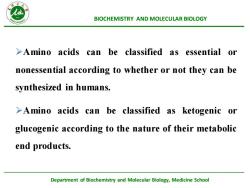
生BIOCHEMISTRYANDMOLECULARBIOLOGY>Amino acids can be classified as essential ornonessential according to whether or not they can besynthesized in humans.>Amino acids can be classified as ketogenic orglucogenic according to the nature of their metabolicend products.Department ofBiochemistry and Molecular Biology,MedicineSchool
Department of Biochemistry and Molecular Biology, Medicine School BIOCHEMISTRY AND MOLECULAR BIOLOGY ➢Amino acids can be classified as essential or nonessential according to whether or not they can be synthesized in humans. ➢Amino acids can be classified as ketogenic or glucogenic according to the nature of their metabolic end products
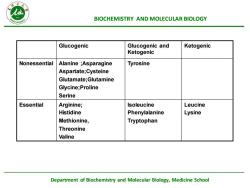
BIOCHEMISTRYANDMOLECULARBIOLOGYGlucogenicGlucogenicandKetogenicKetogenicTyrosineNonessentialAlanine;AsparagineAspartate;CysteineGlutamate;GlutamineGlycine;ProlineSerineEssentialArginine;IsoleucineLeucineHistidinePhenylalanineLysineMethionine,TryptophanThreonineValineDepartment ofBiochemistryandMolecularBiology,MedicineSchoo
Department of Biochemistry and Molecular Biology, Medicine School BIOCHEMISTRY AND MOLECULAR BIOLOGY Glucogenic Glucogenic and Ketogenic Ketogenic Nonessential Alanine ;Asparagine Aspartate;Cysteine Glutamate;Glutamine Glycine;Proline Serine Tyrosine Essential Arginine; Histidine Methionine, Threonine Valine Isoleucine Phenylalanine Tryptophan Leucine Lysine

BIOCHEMISTRYANDMOLECULARBIOLOGYEssential amino acids: these amino acids cannotbe synthesized in humans (or cannot be produced insufficient amounts), and therefore must obtained inthe diet in order for normal protein synthesis to occur.Department ofBiochemistry and Molecular Biology,MedicineSchool
Department of Biochemistry and Molecular Biology, Medicine School BIOCHEMISTRY AND MOLECULAR BIOLOGY Essential amino acids: these amino acids cannot be synthesized in humans (or cannot be produced in sufficient amounts), and therefore must obtained in the diet in order for normal protein synthesis to occur

BIOCHEMISTRYANDMOLECULARBIOLOGYEssential amino acids: Includingphenylalaninevaline,tryptophan,threonine, isoleucine, methioninehistidine, arginine, leucine, lysine.PVTTIMHALLDepartmentofBiochemistryandMolecularBiology,MedicineSchool
Department of Biochemistry and Molecular Biology, Medicine School BIOCHEMISTRY AND MOLECULAR BIOLOGY Essential amino acids: Including phenylalanine , valine, tryptophan , threonine, isoleucine, methionine, histidine, arginine, leucine, lysine. PVT TIM HALL
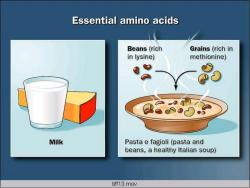
Essential amino acidsBeans(richGrains Crich ininlysine)methionine)MilkPastaefagioli (pasta andbeans,ahealthyItaliansouptiff13.mov
Department of Biochemistry and Molecular Biology, Medicine School BIOCHEMISTRY AND MOLECULAR BIOLOGY
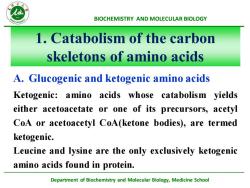
BIOCHEMISTRYANDMOLECULARBIOLOGYl. Catabolism of the carbonskeletonsof aminoacidsA. Glucogenic and ketogenic amino acidsKetogenic: amino acids whose catabolism yieldseither acetoacetate or one of its precursors, acetylCoA or acetoacetyl CoA(ketone bodies), are termedketogenic.Leucine and lysine are the only exclusively ketogenicamino acids found in proteinDepartment ofBiochemistryandMolecularBiology,MedicineSchool
Department of Biochemistry and Molecular Biology, Medicine School BIOCHEMISTRY AND MOLECULAR BIOLOGY A. Glucogenic and ketogenic amino acids 1. Catabolism of the carbon skeletons of amino acids Ketogenic: amino acids whose catabolism yields either acetoacetate or one of its precursors, acetyl CoA or acetoacetyl CoA(ketone bodies), are termed ketogenic. Leucine and lysine are the only exclusively ketogenic amino acids found in protein
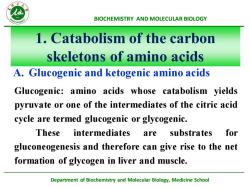
BIOCHEMISTRYANDMOLECULARBIOLOGYl. Catabolism of the carbonskeletonsof aminoacidsA.Glucogenic and ketogenic amino acidsGlucogenic: amino acids whose catabolism yieldspyruvate or one of the intermediates of the citric acidcycle are termed glucogenic or glycogenic.forTheseintermediatessubstratesaregluconeogenesis and therefore can give rise to the netformation of glycogen in liver and muscle.Department of Biochemistry and Molecular Biology,MedicineSchool
Department of Biochemistry and Molecular Biology, Medicine School BIOCHEMISTRY AND MOLECULAR BIOLOGY A. Glucogenic and ketogenic amino acids 1. Catabolism of the carbon skeletons of amino acids Glucogenic: amino acids whose catabolism yields pyruvate or one of the intermediates of the citric acid cycle are termed glucogenic or glycogenic. These intermediates are substrates for gluconeogenesis and therefore can give rise to the net formation of glycogen in liver and muscle
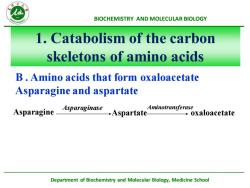
ABIOCHEMISTRYANDMOLECULARBIOLOGYl. Catabolism of the carbonskeletonsofaminoacidsB.Amino acids that form oxaloacetateAsparagineandaspartateAminotransferase Asparaginase Aspartate-AsparagineoxaloacetateDepartment ofBiochemistryandMolecularBiology,MedicineSchool
Department of Biochemistry and Molecular Biology, Medicine School BIOCHEMISTRY AND MOLECULAR BIOLOGY B . Amino acids that form oxaloacetate Asparagine and aspartate 1. Catabolism of the carbon skeletons of amino acids Asparagine Aspartate oxaloacetate Asparaginase Aminotransferase
按次数下载不扣除下载券;
注册用户24小时内重复下载只扣除一次;
顺序:VIP每日次数-->可用次数-->下载券;
- 《生物化学》课程PPT教学课件(留学生)Chapter 33 Molecular Basis of Inherited Disease.ppt
- 《生物化学》课程PPT教学课件(留学生)Chapter 09 Tricarboxylic Acid Cycle.ppt
- 《生物化学》课程PPT教学课件(留学生)Chapter 10 Gluconeogenesis.ppt
- 《生物化学》课程PPT教学课件(留学生)Chapter 28 Vitamins.ppt
- 《生物化学》课程教学资源(文献资料)Lehninger Principles of Biochemistry,5th EDITION,David L. Nelson、Michael M. Cox.pdf
- 《生物化学》课程教学资源(文献资料)临床医本考试大纲.doc
- 《生物化学》课程教学资源(文献资料)临床医本实验大纲 Biochemistry Experiment.doc
- 《生物化学》课程教学资源(文献资料)实验教程.doc
- 《生物化学》课程教学资源(教案讲义)蛋白质的结构与功能.doc
- 《生物化学》课程教学资源(教案讲义)DNA的生物合成.doc
- 《生物化学》课程教学资源(教案讲义)糖代谢.doc
- 《生物化学》课程教学资源(教案讲义)细胞信息转导.doc
- 《生物化学》课程教学资源(文献资料)CURRICULUM FOR UNDER-GRADUATE MEDICAL EDUCATION IN BANGLADESH 2002.pdf
- 《生物化学》课程教学资源(文献资料)Harper’s Illustrated Biochemistry,26th edition,Robert K. Murray Daryl K. Granner Peter A. Mayes Victor W. Rodwell.pdf
- 《生物化学》课程教学资源(文献资料)Syllabus MBBS at the AIIMS(印度).pdf
- 《生物化学》课程教学资源(试卷习题)2012-护理本科-B卷-题目.doc
- 《生物化学》课程教学资源(试卷习题)2012级本科-B卷-题目.doc
- 《生物化学》课程教学资源(试卷习题)2012-护理本科-B卷-答案.doc
- 《生物化学》课程教学资源(试卷习题)2012级本科-B卷-答案.doc
- 《生物化学》课程授课教案(石河子大学:黄瑾).pdf
- 《生物化学》课程PPT教学课件(留学生)Chapter 06 Bioenergetics and Oxidative Phosphorylation.ppt
- 《生物化学》课程PPT教学课件(留学生)Chapter 21 Amino acids - disposal of nitrogen.ppt
- 《生物化学》课程PPT教学课件(留学生)Chapter 07 Introduction of Carbohydrates.ppt
- 《生物化学》课程PPT教学课件(留学生)Chapter 15 glycosaminoglycans.ppt
- 《生物化学》课程PPT教学课件(留学生)Chapter 14 Metabolism of monosaccharides and disaccharides.ppt
- 《生物化学》课程PPT教学课件(留学生)Chapter 01 Amino Acids(structure of amino acid、acid/base properties of amino acid).ppt
- 《生物化学》课程PPT教学课件(留学生)Chapter 01 Amino Acids(overview).ppt
- 《生物化学》课程PPT教学课件(留学生)Chapter 31 Structure and Function of RNA.ppt
- 《生物化学》课程PPT教学课件(留学生)Chapter 20 The metabolism of cholesterol.ppt
- 《生物化学》课程PPT教学课件(留学生)Chapter 29 Metabolism of Nucleotides.ppt
- 《生物化学》课程PPT教学课件(留学生)Chapter 18 phospholipid metabolism.ppt
- 《生物化学》课程PPT教学课件(留学生)Chapter 19 glycolipid metabolism.ppt
- 《生物化学》课程PPT教学课件(留学生)Chapter 32 Biosynthesis of Protein.ppt
- 《生物化学》课程教学资源(PPT课件)18 维生素 Vitamins.ppt
- 《生物化学》课程教学资源(PPT课件)16 血液的生物化学 Hemal Biochemistry.ppt
- 《生物化学》课程教学资源(PPT课件)17 肝的生物化学 Biochemistry in Liver.ppt
- 《生物化学》课程PPT教学课件(留学生)Chapter 30 DNA Structure and Replication.ppt
- 《生物化学》课程教学资源(PPT课件)13 基因表达调控 Regulation of Gene Expression.ppt
- 《生物化学》课程教学资源(PPT课件)15 信号转导(细胞信息传递 Cell Communication and Signal Transduction).ppt
- 《生物化学》课程教学资源(PPT课件)14 基因重组与基因工程 Genetic Recombination and Genetic Engineering.ppt
